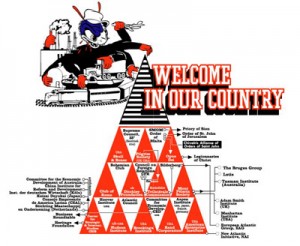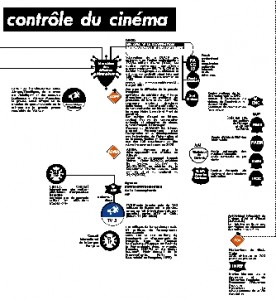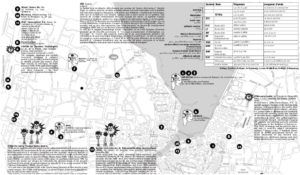 Sophisticated weapons and manipulation systems growing out of the cooperation between universities and armies opened the door to new climatic, tectonic, psychotronic, biological and chemical warfare technologies, which we now find listed in the Space Preservation Act (2001); but also to new coercive techniques founded not only on propaganda and repression, on economic aid, development and humanitarian assistance, but also on the chemical and electromagnetic manipulation of the human body. The most terrible of the American biological operations is said to be the massive spread of AIDS through vaccination campaigns in various Central African countries (1976) and in New York (1977), in order to selectively reduce the threat of the “P-bomb,” or overpopulation (Leonard G. Horowitz, La guerre des virus: Sida et Ebola, 1998). The first American military actions on the weather probably date from the 1970s in Vietnam, followed by the gradual installation of a program for climate control and transformation. Today this program is being developed through the interlinkage of weather information systems (COOP-M and NOAA in the US) and local actions of ionospheric heating through electromagnetic bombardment from arrays of antennas located on several places on the planet (HAARP in Alaska, Arecibo in Porto Rico…). The early research into electrical, then electromagnetic, manipulation of human behavior dates from the 1950s (Mkultra, Pandora) and fits squarely into the mainline development of information science (with the exception of Norbert Wiener, the early cyberneticians were all neurophysiologists).
Sophisticated weapons and manipulation systems growing out of the cooperation between universities and armies opened the door to new climatic, tectonic, psychotronic, biological and chemical warfare technologies, which we now find listed in the Space Preservation Act (2001); but also to new coercive techniques founded not only on propaganda and repression, on economic aid, development and humanitarian assistance, but also on the chemical and electromagnetic manipulation of the human body. The most terrible of the American biological operations is said to be the massive spread of AIDS through vaccination campaigns in various Central African countries (1976) and in New York (1977), in order to selectively reduce the threat of the “P-bomb,” or overpopulation (Leonard G. Horowitz, La guerre des virus: Sida et Ebola, 1998). The first American military actions on the weather probably date from the 1970s in Vietnam, followed by the gradual installation of a program for climate control and transformation. Today this program is being developed through the interlinkage of weather information systems (COOP-M and NOAA in the US) and local actions of ionospheric heating through electromagnetic bombardment from arrays of antennas located on several places on the planet (HAARP in Alaska, Arecibo in Porto Rico…). The early research into electrical, then electromagnetic, manipulation of human behavior dates from the 1950s (Mkultra, Pandora) and fits squarely into the mainline development of information science (with the exception of Norbert Wiener, the early cyberneticians were all neurophysiologists).
Since the origin of information science and technology, the programming/deprogramming/reprogramming of life has been its implicit objective. One can hardly doubt that this objective is on the verge of being attained today, opening the door to a variety of commercial derivatives. The advancement of systems like GPS, the development of biometrics and genetic identifiers suggests that beyond the control of flows and of all multiple identities, there may today exist capacities for the remote control of things and living beings, and for chemical and electromagnetic interaction with them at a distance. The new version of the Internet protocol, IPv6, will increase the number of addresses – 340 billion billion billion billions – allowing every person to be given an address, but also every object, as the latter are increasingly expected to communicate among each other and with human beings. The computerization of complex societies seems well underway toward the implantation of microchips in human flesh, not only allowing gains in systems security through the surveillance of organic components, but also permitting remote control: “prevent voluntary muscular movements, control emotions and actions, produce sleep, transmit suggestions, interfere with both short-term and long-term memory, and both produce and delete an experience set” (Scientific Advisory Committee, U.S. Air Force, 1996).
Having massively invaded all the spheres of society, information science and technology, with its biological and chemical prolongations, now gives rise to a total governmentality. This governmentality does not just contradict the spirit of the Enlightenment by concentrating and augmenting the power of domination exerted by a global aristocracy. It suppresses the very possibility of Enlightenment. The level of bio- and psycho-political management allowed by information science and technology, the level of systemic integration that they make possible, suggest that a political autonomy or constituent power today, of whatever nature, can only become critical by segmenting the infosphere, by developing non-capitalist markets, by setting up revocable hierarchies.
The governmental power exerted over the planet and the species by a caste actively working toward its own immortality is reinforced and multiplied by the integrated technological systems that allow for the analysis of complexity, increasing the capacity for the accumulation of capital, augmenting the capacities of action on information-reality, and even tending toward the administration of future “human resources” via genetic sorting and non-mammalian reproduction.
The world as normed by globalized technological systems and by the strategies of a shadowy planetary government will on the average be more predictable, more certain and better insured than ever in the past, whatever the cultural and functional diversity of that government may be, and whatever the treachery or accidents that may occur (a good example are the American, Russian, German, Israeli and Pakistani secret services, who all knew that something was being prepared for late 2001, or the institutional speculators who were alert enough to sell their stocks in American air carriers shortly before September 11). Thus world government reduces uncertainty, it reduces the capacity to “make history” opened up by a multiplicity of autonomous or sovereign actors.
If what is fundamentally at stake in humanity is making history, and if this capacity is paradoxically reduced by the development of technological systems, then the segmentation of these systems, the limitation of the productive and normative interdependencies, would appear to be the precondition of politics today. Social democracy is entirely contained within the proposition that workers or employees should not destroy their productive instruments, that it is essentially a matter of changing their use or style of management. Social democracy is finished. By reinforcing dependencies, the normalized and normalizing technological systems have destroyed the range of autonomies. They have reinforced the powers of control, standardization and transformation of populations. At stake today is the (re)creation of sovereign autonomies outside planned futures, outside psycho-politics as it is staged in the media on the four corners of the earth, outside salaried labor depending on the worldwide organization of production, on globalized commercial and financial circuits. (Bureau d’études, 2005)
Download map – globallaboratory
 Map American Clubs in english
Map American Clubs in english
 Téléchargez la carte –
Téléchargez la carte –  Sophisticated weapons and manipulation systems growing out of the cooperation between universities and armies opened the door to new climatic, tectonic, psychotronic, biological and chemical warfare technologies, which we now find listed in the Space Preservation Act (2001); but also to new coercive techniques founded not only on propaganda and repression, on economic aid, development and humanitarian assistance, but also on the chemical and electromagnetic manipulation of the human body. The most terrible of the American biological operations is said to be the massive spread of AIDS through vaccination campaigns in various Central African countries (1976) and in New York (1977), in order to selectively reduce the threat of the “P-bomb,” or overpopulation (Leonard G. Horowitz, La guerre des virus: Sida et Ebola, 1998). The first American military actions on the weather probably date from the 1970s in Vietnam, followed by the gradual installation of a program for climate control and transformation. Today this program is being developed through the interlinkage of weather information systems (COOP-M and NOAA in the US) and local actions of ionospheric heating through electromagnetic bombardment from arrays of antennas located on several places on the planet (HAARP in Alaska, Arecibo in Porto Rico…). The early research into electrical, then electromagnetic, manipulation of human behavior dates from the 1950s (Mkultra, Pandora) and fits squarely into the mainline development of information science (with the exception of Norbert Wiener, the early cyberneticians were all neurophysiologists).
Sophisticated weapons and manipulation systems growing out of the cooperation between universities and armies opened the door to new climatic, tectonic, psychotronic, biological and chemical warfare technologies, which we now find listed in the Space Preservation Act (2001); but also to new coercive techniques founded not only on propaganda and repression, on economic aid, development and humanitarian assistance, but also on the chemical and electromagnetic manipulation of the human body. The most terrible of the American biological operations is said to be the massive spread of AIDS through vaccination campaigns in various Central African countries (1976) and in New York (1977), in order to selectively reduce the threat of the “P-bomb,” or overpopulation (Leonard G. Horowitz, La guerre des virus: Sida et Ebola, 1998). The first American military actions on the weather probably date from the 1970s in Vietnam, followed by the gradual installation of a program for climate control and transformation. Today this program is being developed through the interlinkage of weather information systems (COOP-M and NOAA in the US) and local actions of ionospheric heating through electromagnetic bombardment from arrays of antennas located on several places on the planet (HAARP in Alaska, Arecibo in Porto Rico…). The early research into electrical, then electromagnetic, manipulation of human behavior dates from the 1950s (Mkultra, Pandora) and fits squarely into the mainline development of information science (with the exception of Norbert Wiener, the early cyberneticians were all neurophysiologists). Carte produite à l’occasion du Sommet sur les société de l’information à Geneve.
Carte produite à l’occasion du Sommet sur les société de l’information à Geneve.